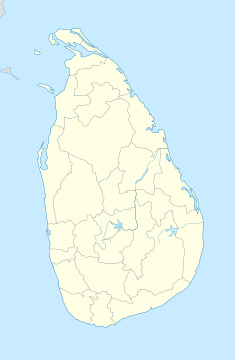- Norocholai Power Station
-
Norocholai Coal Power Station Location of Norocholai Coal Power Station Country Sri Lanka Location Norocholai, Puttalam Coordinates 08°01′00″N 79°43′24″E / 8.0166667°N 79.72333°ECoordinates: 08°01′00″N 79°43′24″E / 8.0166667°N 79.72333°E Status Operational Construction began May 11, 2006 Commission date March 22, 2011 Construction cost US$ 1,350 million Operator(s) Ceylon Electricity Board Constructor(s) CMEC Power station information Primary fuel Coal Combined cycle? Yes Power generation information Installed capacity 300 MW Maximum capacity 900 MW Annual generation 1,658 GWh The Norocholai Power Station (also known as the Lak Vijaya Power Station) is a large coal-fired power station in Norocholai, Puttalam, Sri Lanka. Construction of the 900 MW facility was segmented into three 300 MW phases, officially beginning on May 11, 2006.[1]
The first 300 MW block was ceremonially commissioned by President Mahinda Rajapaksa on March 22, 2011 at 18:27 local time, with the presence of Minister of Energy Champika Ranawaka, deputy Minister of Energy Premalal Jayasekara, and Minister of Public Administration W. D. J. Senewiratne,[2] whose vehicle collided with a bus while arriving at the opening ceremony, causing minor injuries to both the minister and his driver.[3][4]
After the completion on the latter stages in 2013, it would surpass all power stations and rank as the largest power power producing body in the country, at 900 MW. This record is expected to be broken by the 1,000 MW Sampur Coal Power Station, to be commissioned in 2014.
According to the Ceylon Electricity Board, this US$455 million first phase would be able to generate nearly 1.7 TWh of energy annually upon completion in 2013; a major milestone in meeting the growing energy demand.[1] The plant will be connected to the grid via 115 km (71 mi) long 220-kilovolt transmission line. Power station exhausts are emitted through 150 m (492 ft) tall chimneys, one of the country's tallest man-made structures.[1]
Contents
Environmental impact
During its pre-development stages, numerous protests were carried out by residents living near the project site, claiming that they were deceived by the government.[5] The power station risks several negative factors including:
- Water usage by the power station would cause coastal erosion
- Emissions of sulphur dioxide contributes to acid rain, harming local agriculture
- Emissions of carbon dioxide and carbon monoxide contributes to greenhouse effects and global warming
- Discharge of warm water to the sea negatively affects corals and marine life
- Coal dust from the station may cause respiratory diseases to residents living in the vicinity, and also affect ground water quality
- The project involves large-scale logging which will heavily affect the water table
According to the Ministry of Power and Energy, some of these issues have now been solved.
October 2010 fire
A large fire had broken out on October 24, 2010. According to the Ceylon Electricity Board, there were no casualties. The Ministry of Power and Energy commented that damages to the facility would be borne by the constructors, and not the government or the developers.[6]
See also
- List of power stations in Sri Lanka
References
- ^ a b c "Norocholai Coal Power Plant Project" (in English) (PDF). Ministry of Planning and Finance. http://www.fabm.gov.lk/downloads/Norochcholai.pdf. Retrieved 23 March 2011.
- ^ Perera, Chaminda (22). "Commissioning of Norocholai Power Station" (in English). Daily News (Norocholai, Puttalam). http://www.dailynews.lk/2011/03/23/news01.asp. Retrieved 23 March 2011.
- ^ "Minister injured in accident" (in English). Daily News. http://www.dailynews.lk/2011/03/23/news54.asp. Retrieved 23 March 2011.
- ^ "Minister's vehicle collides with bus" (in English). Daily Mirror. http://www.dailymirror.lk/news/10486-ministers-vehicle-collides-with-bus.html. Retrieved 23 March 2011.
- ^ Displaced families complain of shocking deception (Sunday Times News)
- ^ "Government won't bear costs of Norocholai fire". Ada Derana. http://www.twww.adaderana.lk/news.php?nid=10322. Retrieved 2 December 2010.
Categories:- Coal-fired power stations in Sri Lanka
- Buildings and structures in North Western Province, Sri Lanka
Wikimedia Foundation. 2010.

